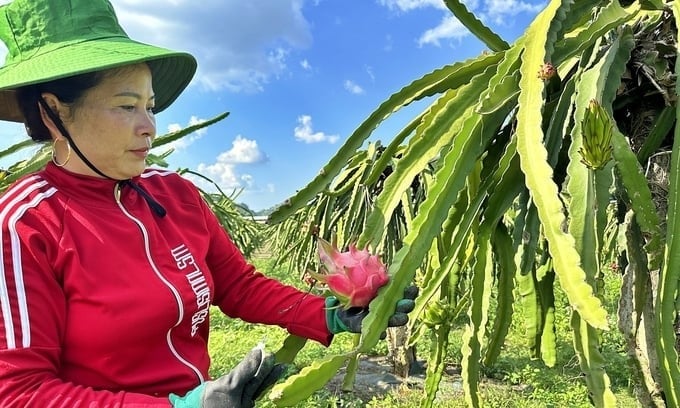October 28, 2025 | 14:35 GMT +7
October 28, 2025 | 14:35 GMT +7
Hotline: 0913.378.918
October 28, 2025 | 14:35 GMT +7
Hotline: 0913.378.918

Ms. Dung personally hand-pollinates off-season dragon fruit buds to stimulate flowering. Photo: Duc Binh.
Ngoc Hoang Cooperative – formerly, local farmers mainly cultivated crops such as corn, beans, and peanuts. However, these crops yielded low income. At that time, the cooperative had not yet been established. Mr. Nguyen Quang Vinh (now the Director of the Cooperative) received support from the Fruit and Vegetable Research Institute, which introduced red-fleshed dragon fruit varieties and brought them to Son La for trial planting.
After successfully growing the crop, Mr. Vinh shared his experience and guided surrounding households on cultivating and expanding dragon fruit farming.
On March 18, 2016, Ngoc Hoang Cooperative was officially established with 11 pioneering members, most of whom had followed Mr. Vinh in growing dragon fruit. During the cultivation process, we realized that dragon fruit brought high economic returns. However, since dragon fruit had not yet been recognized as a key crop of the province at the time, its development faced many challenges.
We boldly proposed to the provincial leadership that dragon fruit be included in the list of key crops. Since then, with the close attention and direction from the province, we have received support from various departments, sectors, and local leaders.
Relevant units came directly to the area, worked alongside local farmers to sell products, understood the living conditions, and assisted with trade promotion, helping us advertise our products. The role of the press and media in promoting Son La dragon fruit has also been very important. Thanks to these efforts, our dragon fruit products have reached many other provinces and cities.
In the past, we were very worried because we didn’t know how to sell our products. However, thanks to trade promotion activities, traders and customers from various regions are now aware of and come to purchase Son La dragon fruit. The reason is that Son La dragon fruit is of high quality due to the region’s unique soil and climate conditions, especially the temperature difference between day and night.

Many delegations have visited to learn from the Ngoc Hoang Cooperative model. Photo: Duc Binh.
Additionally, the people of Son La are renowned for their diligence and eagerness to learn. They actively seek knowledge not only through the media but also from books and training courses. This helps us effectively apply scientific and technical advances in agricultural production. Notably, today, not only dragon fruit but also many other types of fruit in Son La can be grown off-season. In the past, dragon fruit was not available during the Lunar New Year holiday, but now it is present, serving both the people of Son La and those in other provinces.
We have explored and learned how to control the flowering time to ensure both the yield and quality of the fruit, meeting export standards. Since 2017, we have oriented our production towards organic practices, strictly managing inputs and outputs, and planning cultivation zones. We have also proactively connected with businesses to promote and distribute our products.
Son La is likened to the "giant air conditioner" of the Northwest, with its many microclimates, a temperature difference of 4–5 degrees Celsius between day and night, and mountainous terrain — all of which create ideal conditions for dragon fruit cultivation. Taking advantage of these natural conditions, Ngoc Hoang Cooperative now produces high-quality dragon fruit that meets the requirements for export to the EU market.
For export, the inspection process is very strict. Many delegations from abroad visit Vietnam to collect soil and water samples for testing, maintain production logs, monitor the frequency of organic pesticide applications, and oversee care procedures. After harvesting, the cooperative must send 6 to 8 samples to Ho Chi Minh City for further testing. Only when all requirements are met can the products be exported.
By 2018, our dragon fruit products began to be exported to markets such as France, Russia, Japan, and Italy. However, the cooperative has not yet been able to export directly and still must go through intermediaries. Nevertheless, the product quality has been highly appreciated by customers, and orders have been increasing steadily.
In 2024, due to unfavorable weather conditions, export volume reached only about 800 tons. But in 2025, after improved inspection and control of the cultivation areas, we estimate export volume could reach approximately 1,600 tons. Many businesses have already signed contracts to secure product purchases. However, we still face challenges from harsh climate conditions, with prolonged droughts lasting 7 to 8 months causing significant damage to the crops.
Despite this, dragon fruit is a drought-resistant crop and still provides stable income. To ensure a consistent output, we have advised members to proactively identify water sources and apply reasonable irrigation methods to guarantee quality and quantity that meet the export requirements for 2025.
Translated by Phuong Linh

(VAN) SEAMAP and ROMONA sign a 2025 - 2028 Memorandum of Understanding, marking a new chapter in Viet Nam’s marine geodesy and positioning technology development.

(VAN) UNICEF, in cooperation with the Ministry of Agriculture and Environment, has provided 800 water storage tanks, 800 essential hygiene kits, and 80,000 water purification tablets to people affected by the recent floods.

(VAN) More than 32,000 plant genetic samples currently preserved in Vietnam’s National Genebank are laying the foundation for the establishment of a National Botanical Garden and the development of climate-resilient crop varieties.

(VAN) Viet Nam is emerging as a strong potential contributor to the ASEAN Economic Community, thanks to its outstanding competitiveness in manufacturing and production.

(VAN) On October 25, the VDDMA received emergency aid from Singapore for people affected by recent disasters.

(VAN) The Viet Nam Academy of Science and Technology and the Finnish Meteorological Institute have signed a five-year Memorandum of Understanding.

(VAN) Amid severe salinity intrusion, the groundbreaking of Dong Tam Water Plant marks a milestone for sustainable water security in the Mekong Delta.